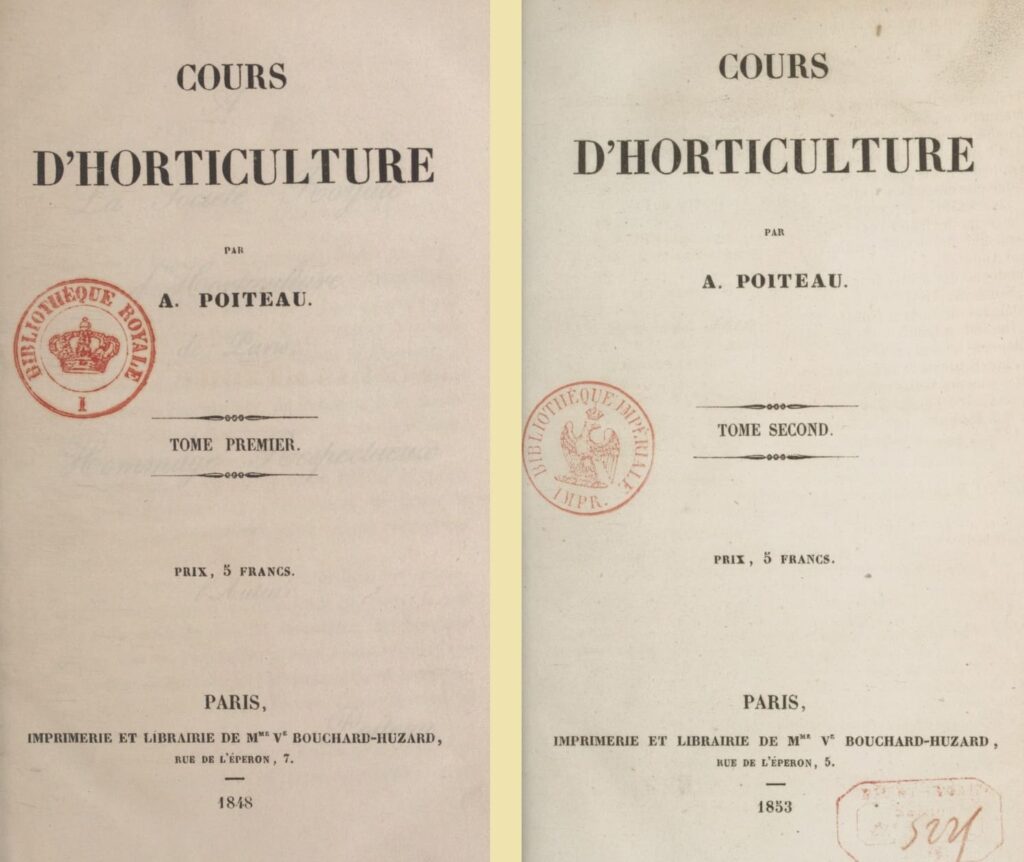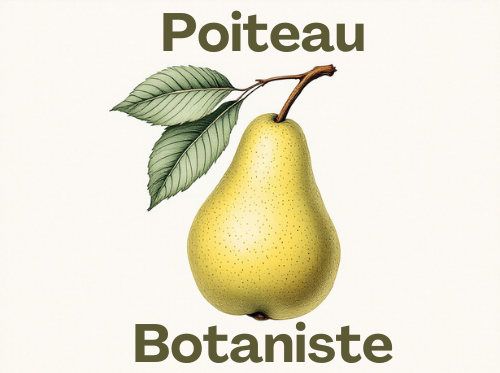Introduction
The Cours d’Horticulture by Pierre-Antoine Poiteau , published between 1848 and 1853 in 2 volumes (see Volume 1 , Volume 2 on BnF/Gallica ), is a valuable testimony to horticultural knowledge of the 19th century.
This methodical work, combining theory and practical application, was originally designed for students at the Royal Horticultural Institute of Fromont (1829 – 1830) .
Poiteau, botanist, horticulturist and illustrator , dedicated his life to the knowledge of plants and the improvement of cultivation techniques. In his Horticulture Course , he aimed not only to instruct future horticulturists, but also to lay a solid scientific foundation for a more rational approach to agriculture and arboriculture.
The content of the Horticulture Course:
- Volume 1: Fundamental scientific bases (geology, climatology, chemistry applied to horticulture).
- Volume 2: Horticultural practices and fruit growing (nursery training, grafting, orchard maintenance).

Tome 1st and 2nd
( Photo Credit : BnF/Gallica)
While some of the methods Poiteau outlined are still in use today, others have been replaced by more sustainable practices adapted to current environmental challenges.
A structured and avant-garde education for the time
📌 Solid Scientific Foundations
Unlike many works of his time, Poiteau did not simply describe horticultural techniques empirically. The Horticulture Course introduces a scientific approach by explaining the interactions between plants and their environment:
- Geology and nature of soils : It details the types of soils and their impact on crop growth.
- Climate influence : It analyzes exposure, humidity and thermal variations.
- Chemistry concepts : It deals with plant nutrition and the influence of minerals, anticipating future studies on fertilizers.
This knowledge, still innovative in the 19th century , laid the foundations for many modern horticultural practices and remains essential in agroecology and permaculture.
🌿 But how have these methods evolved over time? Some techniques described by Poiteau are still widely used, while others have been adapted or replaced by more sustainable and effective approaches.
🔎 This page offers a comparative analysis between the teachings of the Horticulture Course and current practices, providing an enlightening look at the evolution of this fundamental art.
Practices still relevant today
🌱 Multiplication and propagation of plants
✅ Grafting, cuttings, layering
- The shield, cleft or approach grafting methods described by Poiteau are still used, particularly in arboriculture and viticulture.
- Cuttings and layering , allowing the reproduction of plants without going through seeds, remain major techniques.
✅ Use of rootstocks
- In his Horticulture Course, Poiteau emphasizes the importance of
choosing a rootstock adapted to the soil and climate , a strategy still applied today to improve crop resistance.
🌾 Soil management and fertilization
✅ Crop rotation and organic amendments
- He advocates crop rotation to preserve soil fertility, a fundamental principle in organic farming and agroforestry .
- He recommends the use of compost, manure and ashes , techniques that are still relevant in sustainable agriculture .
☀️ Exposure and climate
✅ Optimization of sunlight and protection against wind
- He emphasizes the importance of microclimate and windbreak hedges to protect crops.
- It promotes espalier cultivation , a technique still used to optimize light and heat on the fruits.
🍏 Varietal selection and fruit improvement
✅ Selection of varieties according to climate and soil
- He recommends adapting the choice of fruit varieties to the characteristics of the soil and climate, a fundamental principle of modern arboriculture.
✅ Fruit improvement by selection and grafting
- It highlights the progressive selection of the most productive and resistant trees, a method still essential today.
Obsolete or Outdated Practices
🚜 Soil cultivation techniques
❌ Deep plowing and intensive digging
- Poiteau recommends turning the soil over deeply , a practice now questioned because it destroys the structure of the soil and disrupts microbial life.
- Modern techniques favor no-till and mulching to preserve the soil ecosystem.
🌿 Crop protection and disease control
❌ Use of archaic treatments
- Poiteau recommends the use of sulfur powders and mineral salts , now replaced by more targeted biological treatments.
🐛 Pest control methods
❌ Systematic burning and uprooting of diseased trees
- He recommends the complete destruction of diseased trees, while biological control now makes it possible to restore the natural balance.
🌧️ Watering and water management
❌ Intensive manual watering
- At the time the Horticulture Course was written, irrigation was rudimentary. Today, water-saving systems such as drip irrigation or moisture sensors are used.
Innovations and Modernizations
🔄 Improvement of fruit varieties
- Poiteau used grafting and successive sowing , while today we have in vitro culture and genomic selection
🏡 Greenhouse cultivation
- The greenhouses described by Poiteau in his Horticulture Course were rudimentary, while modern greenhouses allow precise control of temperature and humidity .
🌱 Soil protection
- Poiteau advocated natural mulching , whereas today we have perfected this method with mulching and permanent plant cover.
Conclusion: Knowledge that is always relevant and must be adapted
The Poiteau Horticulture Course remains an essential reference, demonstrating an approach that was already rational and rigorous in the 19th century. Many of its principles remain relevant today, while others have evolved thanks to technological and scientific progress.
By revisiting his work, we better understand the evolution of horticulture and pay tribute to a pioneer in the transmission of botanical knowledge.
🌿📚 Dive into its heritage and explore the fascinating history of horticulture!
Explore more of Pierre-Antoine Poiteau’s Legacy
Pierre-Antoine Poiteau ‘s work is not limited to his Horticulture Course : it is a lifetime of work dedicated to botany, exploration, and scientific illustration that deserves to be discovered.
📖 Delve into his biography and follow the exceptional journey of a passionate autodidact, who rose from humble beginnings to become one of the greatest botanists of his time.
🌿 Explore his botanical expeditions to Santo Domingo and
French Guiana , where he collected hundreds of plant species, braved political turmoil, and laid the foundations for numerous scientific works.
🍊 Discover his major works , including the Histoire Naturelle des Orangers, an illustrated masterpiece celebrating citrus fruits, or the
Traité des Arbres Fruitiers and Pomologie Française , essential references in arboriculture.
🎨Admire his botanical illustrations , witnesses to unique artistic and scientific know-how.
📌 Want to learn more? Continue your exploration at
poiteau-botaniste.com and immerse yourself in the fascinating world of Pierre-Antoine Poiteau! 🚀🌱
